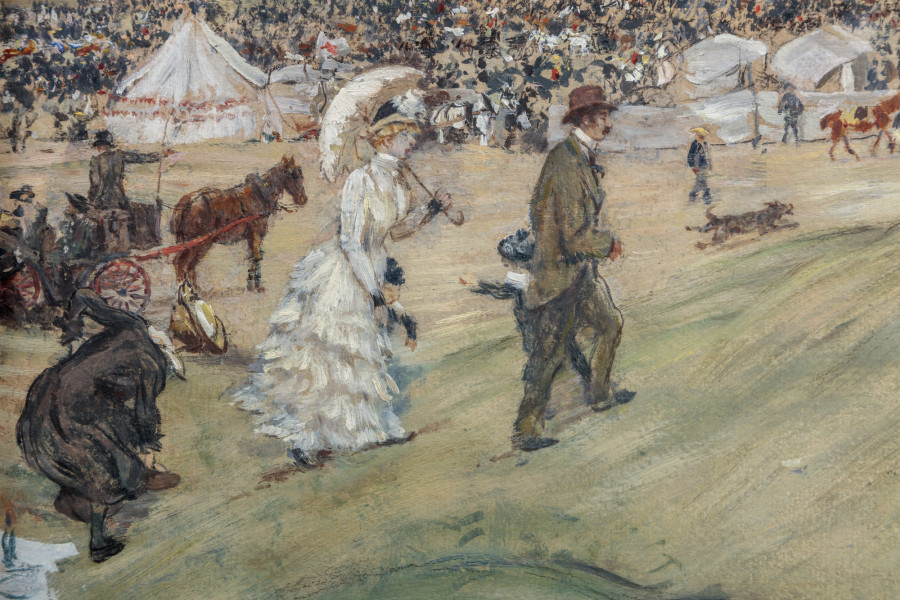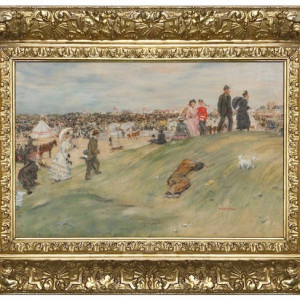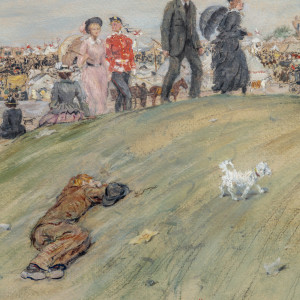Like his mentor, Degas, Raffaëlli was not always interested in capturing the action of the horse race, but instead was more focused on depicting the milieu of the scene. It is therefore not coincidental that Raffaëlli’s Races at Jersey shares attributes with some of Degas’s most well-known racing subjects.
Provenance
Jules Clarétie, Paris (and sold his sale, Hôtel Drouot, Paris, 6 May 1914, lot 46)
Jeanne Lanvin, Paris, by 1926
By descent to Marie-Blanche Lanvin, Comtesse Jean de Polignac, Paris
Thence by descent
Exhibited
Paris, Boussod & Valadon, Jean-François Raffaëlli, 27 May-21 June 1890, no.20
Paris, Galerie Georges Petit, Exposition Jean François Raffaëlli, June 1909, n° ?
Maisons-Laffitte, Château de Maisons-Laffitte, Les courses en France des origines à nos jours, 1926, no. 366, mentioned in the catalogue no. 61 p. 18 (as Champ de courses à Jersey)
Catalogue note
Raffaëlli painted two of his most interesting and significant works in the early 1880s: Absinthe Drinkers (Private Collection) and Man having just painted his Fence (Private Collection). It is therefore not surprising that they represent the highest and third highest prices ever paid for Raffaëlli at auction. Each work also shares an impressive exhibition history; both were included in the Sixth Impressionist Exhibition in 1881. The controversy over this show – who exhibited and who did not – has been hotly debated ever since 1881 when it was in its early stages of organization. In the end it did not include Monet, Renoir and Sisley, who had been part of the 1874 inaugural exhibition, and Caillebotte refused to exhibit, believing that the inclusion of an artist like Raffaëlli threatened the essential pastoral character of Impressionism in favor of Realism. However, at the insistence of Degas, perhaps the most influential member of these landmark exhibitions, Raffaëlli took part in 1881. Historically speaking, the presence of Raffaëlli may have advanced the notion of Realism as a significant characteristic of Impressionism as we understand it today.
Like Degas, Raffaëlli did not join the Impressionist group exhibition the following year; instead, he spent the summer of 1882 painting on the Island of Jersey, which became his favorite summertime destination for the following four years. Here, Raffaëlli found a new “type” to explore as a subject, and his chiffonniers from Asnières were replaced by Jersey fishermen and soldiers and vacationers from England. One of the main attractions on the Island was the Jersey Race Club at Gorey, the village where Raffaëlli had his summer house and the subject of our painting. Scenes at the racetrack were popular subjects for contemporary French artists such as Manet and Degas, not to mention the prolific output of artists like John Frederick Herring, Snr. on the other side of the Channel. Like his mentor, Degas, Raffaëlli was not always interested in capturing the action of the horse race, but instead was more focused on depicting the milieu of the scene. It is therefore not coincidental that Raffaëlli’s Races at Jersey shares attributes with some of Degas’s most well-known racing subjects, and especially At the Races in the Countryside (Museum of Fine Arts, Boston), which Degas first exhibited at the 1874 Impressionist exhibition. While the two paintings are not identical, what strikes the viewer in each work is the choice of an unconventional and complex composition. More than half of Raffaëlli’s painting is devoted to showing an empty green hillside, and apart from the sleeping boy, possibly a stable lad, placed on the hill like a Colorform cut out and a small white dog, there are no people. The spectators are shown climbing the side of the hill or seated on the ground and appear as crowded masses in the distance. Only one tiny racehorse is visible in the center of the painting. Like so many of Raffaëlli’s paintings, his interest is in depicting the various “types” that inhabit a specific milieu and here he convincingly shows a mix of local folk, and foreign vacationers set in an unconventional and highly innovative format representing the setting of the Jersey Race Club at Gorey.
The earliest owners of Races at Jersey were the French novelist and playwright, Jules Claretie followed by the famed fashion designer, Jeanne Lanvin.








